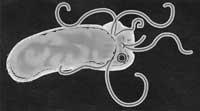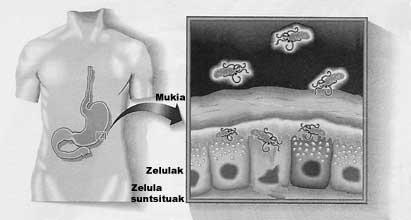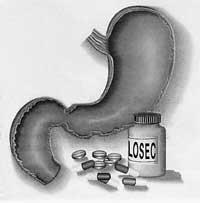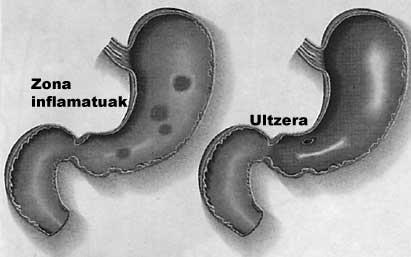Ulcer can be cured

So, reader, you know: the main culprit of your disease is a gram-negative bacillus (Helicobacter pylori) and not the coffee you drink daily or the stress or restlessness you suffer in the work.The researchers have discovered that bacterium in 90% of cases of ulcer and gastritis that have nothing to do with the genetic factors or the foods mentioned. However, for the majority of the population, and also for many patients with ulcer, Helicobacter pylori remains unknown.
This is demonstrated, at least, by the last opinion poll conducted among us on peptic ulcer promoted by pharmaceutical firm Schering-Plough. People do not know the role of the Helicobacter bacillus in the origin of the ulcer. Even more, among those affected by the ulcer, 38% are those who have known the bacillus in press and media and only 20% have known it by the mouth of the doctors. And if we analyze these figures in the general population, it is observed that they are still lower (27% and 4% respectively). As you can see, even though Helicobacter pylori has raised quite a lot of dust among doctors, there has still not been much news among people.
What is Helicobacter pylori?
Bacilo gram is negative, elongated, spirally shaped, with a XXXX flagellum that gives it motor capacity (see figure below). Despite the attack of gastric acid on the digestive mucosa, an enzyme (ureasa) that flows bacillus converts the urea of the gastric juice into ammonia and bicarbonate, making the medium less acidic. In this way it reaches the mucosa of the stomach and, once there, it extends through the mucosa that covers the mucosa. Muquía is an ideal place for the growth and reproduction of Helicobacter pylori, where you will not find any competition for other germs. In addition, the immunoglobulins that the body creates as a protection mechanism against foreign substances are not able to destroy the bacillus.

What does Helicobacter pylori do?
The first sign indicating the beginning of the infection is acute gastritis, which lasts about two weeks (pain, vomiting, etc. ). ). Inflammation progresses and in some cases, although the patient has no symptoms, chronic gastritis will occur that can last many years (heavy digestions, hearts, etc. ). ). Thanks to the characteristics of the bacteria, the genetic predisposition of the person or other factors, when there are too many acids in the stomach the injury can progress to become peptic ulcer.
What is an ulcer?

The ulcer is a wound that appears almost always in the mucosa of the duodenum and much less in the mucosa of the stomach. The main symptom that produces is pain, which is seen in the mouth of the stomach and is slowly calming; in the case of gastric ulcer, it is seen in the succession of meals and in the ulcer of the duodenum, approximately one hour after the meal. In either case, the ulcer may present associated problems (hemorrhages, orifices, etc.) And that's why it's always very important to keep it in mind.
In addition, due to the symptomatology of the ulcer, the quality of life of the patient is also significantly altered: changes of humor, alterations of the family and work environment and moderately recurrent resuscitations, until reaching the patient from the cronicity, with the set of consequences that entails (consumption of drugs, dietary restrictions, etc. ). ).
Current situation
Fortunately the situation has begun to change. Having discovered the role of Helicobacter pylori in the genesis of the disease, there has been a real revolution in the treatment of ulcer. Until now the treatments decreased the excessive acidity of the stomach, but did not cause the disappearance of the bacteria that caused the infection. Consequently, gastritis persisted and, of course, the risk of the appearance of new ulcerative episodes. The survey promoted by Schering-Plough shows that cronicity and tendency to recovery are the basic problems of the ulcer.
According to the same survey, 56% of patients with peptic ulcer suffer from it for ten or more years, and it is estimated that in 1,200,000 cases it has reappeared after the scarring with conventional treatments. In the mid-1970s, antagonists H 2 appeared on the market, drugs that reduced or decreased acid secretion; after eight weeks of treatment, 90% of ulcers were healed. The last inhibitor of the secretion of acids, with great success, was omeprazole, which allowed healing of more than 95% of duodenal ulcers after four weeks of treatment.

However, and without denying at all the importance of these advances, the frequency of the repositions remained a problem. All investigations have had the same goal: to definitively cure the disease it is necessary to eliminate the bacillus Helicobacter pylori. All types of drugs are still used to reduce acid, especially because it greatly relieves pain and the rest to the patient, although today it is proposed to add antibiotics to anti-acid drugs.
The best results obtained between us are chloritromycin, amoxizitrine and metronidazole (seven years without symptoms). The recovery index has decreased drastically, which allows to affirm that the ulcer can be cured definitively. However, most patients affected by ulcers are still treated with antacids and acid inhibitors, and antibiotics are rarely used. Well, you have to improve a lot in the treatment.
Buletina
Bidali zure helbide elektronikoa eta jaso asteroko buletina zure sarrera-ontzian











